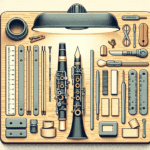The quality of your reeds plays a vital role in clarinet performance. A properly maintained reed can greatly improve your tone, response, and overall playing experience. One key skill for clarinet players is the ability to file reeds to achieve the desired sound and response. This article compares various clarinet reed filing tools, their features, and the importance of investing in quality tools, with a focus on the expertise associated with Martin Freres.
Understanding Reed Filing
Reed filing is the process of sanding or shaping the reed to adjust its thickness and responsiveness. This customization helps adapt the reed to a player's individual style and preferences. Effective filing can also enhance control over pitch and dynamics, which are crucial elements of musical expression.
Types of Reed Filing Tools
Several tools are available for reed filing, and choosing the right one can significantly affect the outcome of your reed adjustments. Let's explore some of the most commonly used reed filing tools:
Reed Filing Tool Comparison
1. Reed Filing Machines
Reed filing machines are electrical devices that help streamline reed adjustments. These machines offer precise control over the filing process, making them ideal for players who are particular about their sound.
- Benefits: Consistent results, quick adjustments, and user-friendly operation.
- Drawbacks: Higher upfront cost and a learning curve for efficient use.
2. Manual Reed Cutters
Manual reed cutters are tools designed for precise and consistent reed trimming. They're particularly useful for players who prefer a more hands-on approach to reed adjustment.
- Benefits: Enhanced control during adjustments and generally more affordable.
- Drawbacks: Requires skill to use effectively and may be more time-consuming than mechanical options.
3. Sanding Blocks
Sanding blocks are common tools in reed filing. They enable players to shape and flatten the reed according to their preferences, often resulting in a pleasing sound.
- Benefits: Easy to use, portable, and budget-friendly.
- Drawbacks: Achieving perfect consistency can be challenging without practice.
4. Reed Files
Specialized reed files are crucial for making precise adjustments. Available in various shapes and sizes, they allow for targeted filing.
- Benefits: Highly precise, excellent for detailed work.
- Drawbacks: Requires expertise and practice to use effectively.
Comparison of Reed Filing Tools
Here's a detailed look at some popular tools available for reed filing:
| Tool | Best For | Price Range | Comments |
|---|---|---|---|
| Reed Filing Machine | Professionals or serious players | $100 – $300 | Offers consistent results easily; requires regular maintenance. |
| Manual Reed Cutter | All skill levels | $20 – $50 | Cost-effective, provides good control but requires practice to master. |
| Sanding Block | Beginners or casual players | $5 – $15 | Basic tool, less precise; effective for general shaping. |
| Reed File | Intermediate to advanced players | $10 – $30 | Highly precise, ideal for fine adjustments but requires careful handling. |
Choosing the Right Tools
The selection of reed filing tools largely depends on your skill level and objectives. For beginners, starting with simpler tools like sanding blocks and manual cutters might be the best approach as you hone your technique. More experienced players or professionals might find value in investing in a reed filing machine, as it can be time-efficient while delivering customized results.
Martin Freres tools are known for their quality craftsmanship, which can enhance your playing experience. Regardless of your tool choice, dedicating time to develop your reed filing skills will positively impact your overall musicianship.
Essential Tips for Successful Reed Filing
- Explore Different Options: Try various tools and techniques to discover what suits your playing style best.
- Maintain Consistency: Establish a routine for filing your reeds to ensure consistent performance.
- Track Adjustments: Record the changes you make and their impact on your sound to refine your technique over time.
- Regular Practice: Like any musical skill, consistent practice leads to improvement in reed filing.
Mastering reed filing will not only enhance your sound but can also increase your enjoyment of playing the clarinet as you become more attuned to your instrument. Whether you're making minor tweaks or significant alterations, the right combination of tools, knowledge, and practice can help you achieve your desired sound.







